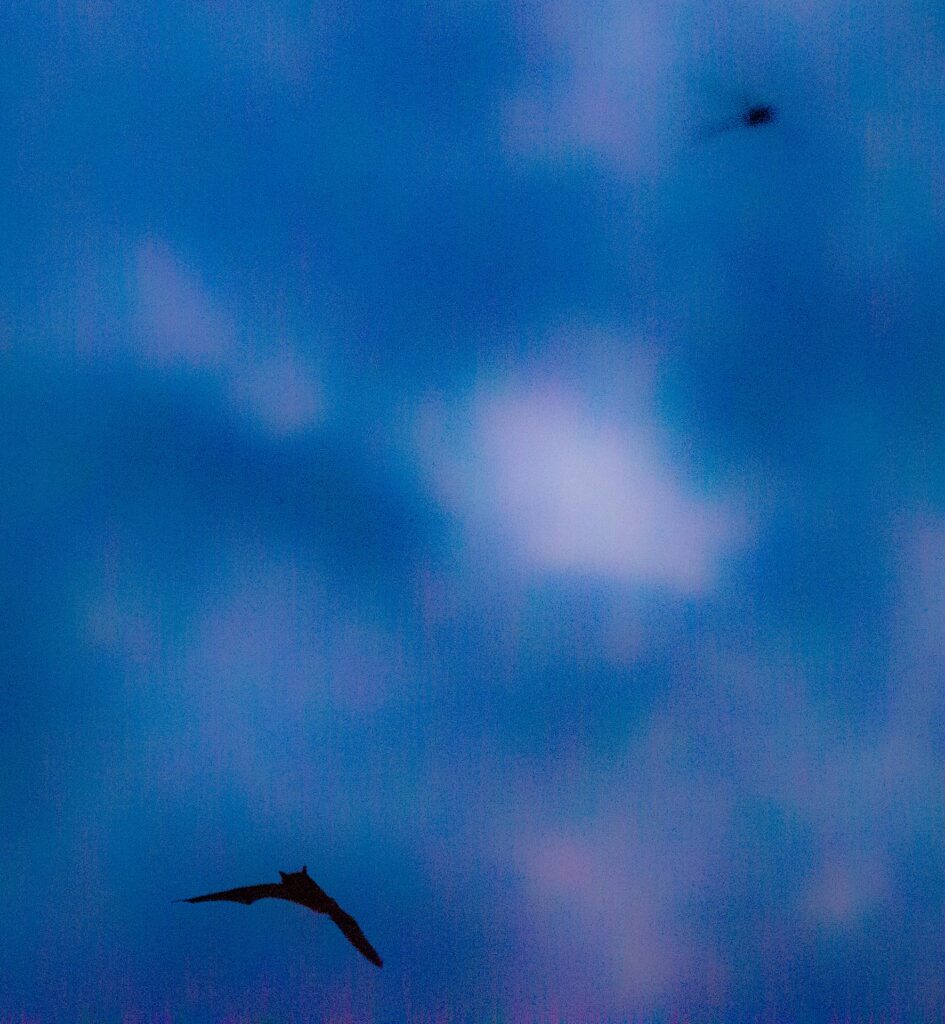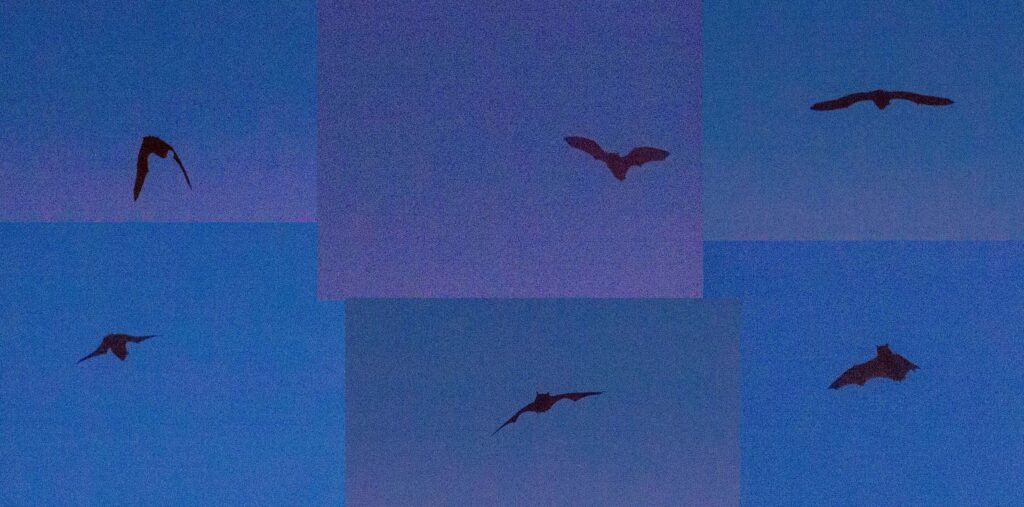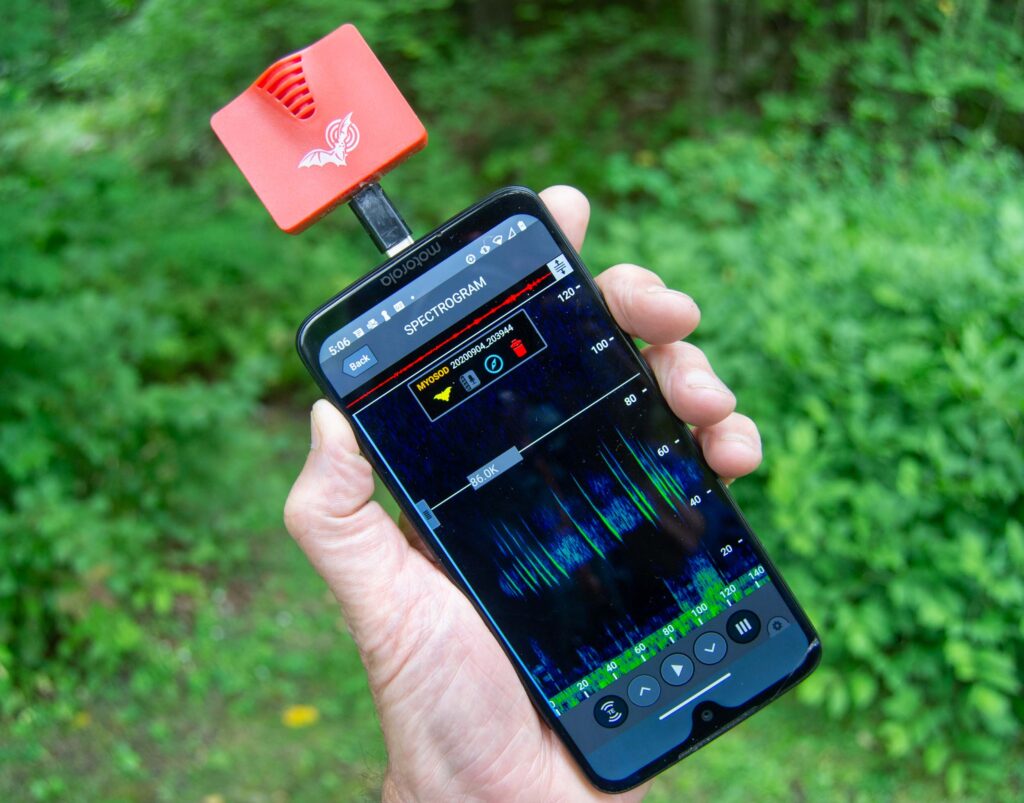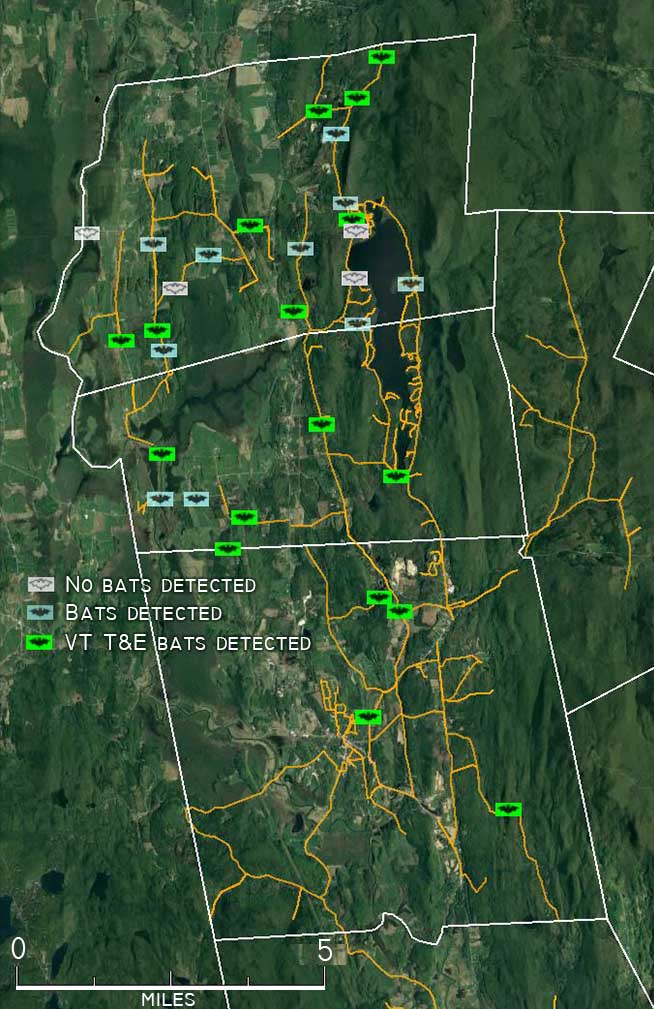This summer there was a bat or two flying over the yard every evening, so I started lying in wait for them with a camera. For about 15 minutes at dusk there was enough light to capture a bat silhouette if I used a good DSLR at the highest ISO. The photos were fun, but you can’t tell what kind of bats they are from the photos. Someone suggested using a bat detector — an ultrasonic microphone that listens to the otherwise silent calls of bats and even suggests which species are calling.


Bat detectors are typically rather expensive, but Wildlife Acoustics makes an ultrasonic microphone that plugs into a smartphone’s charging port and has a free app to record ultrasonic sounds. The app can show you an animated sonogram of the inaudible sounds and play a version of them at audible frequencies. After making a short recording of a call it suggests which species of bat was calling. The microphone costs $179, but the Android version was out of stock. I trolled eBay until a used one appeared for $100 and bought it.

At the very hour my Echo Meter Touch 2 arrived in the mail my home internet started a three day outage. I had already loaded the app onto the phone, but I had not downloaded the user manual or watched the instructional videos (and I had to ration my phone data during the internet outage). So at dusk, I was poorly prepared when I went into the backyard at the usual time and turned on “Live mode.” A few seconds later the phone started to chirp. I looked up and a bat was flying over. A moment later the phone chirped again and I touched the record button. When the chirping stopped I touched “Stop” and was told that it was a big brown bat (Eptesicus fuscus). The next thing I knew it was 35 minutes later and I had recorded 30 calls of big brown bats and little brown bats (Myotis lucifugus). It was dark by then and I hadn’t seen more than two of the bats that had flown past probably within 150 feet of me (the approximate effective range of the microphone for our bats).
Above: A screen capture of a sonogram and an audible version of one of my recordings as it is played in the computer program Kaleidoscope Pro. A big brown bat (first, lower, slower) is followed by a little brown bat (second, higher, faster). Assignment of the species to each sonogram was done by the $400 part of Kaleidoscope Pro so it might be correct.
A rash decision was made and the next thing I knew I was a mile down the road recording bat calls. I still didn’t know how to use most of the app features or to optimize the species identifications, but on-the-job training was my only option. Mindful that with no internet there was not much to do at home, I drove all over Salisbury stopping where I could pull off the road safely in the dark and didn’t get home until 11:00 PM.
Above: A screen capture of a sonogram and an audible version of one of my recordings as it is played in the computer program Kaleidoscope Pro. Some bats have similar calls so it’s possible that the little brown bat (first, higher, faster) is really an Indiana bat and that the silver-haired bat (second, lower, slower) is a hoary bat.
I did this for four nights in a row, under a full moon or in a warm drizzle, on richly rural roads I had never driven before, making it as far as Brandon village on one night. I made almost 300 recordings, each 5-15 seconds long, but many of them had no bats, or had other noise, or had multiple bats fouling the data. Most of the recordings had been automatically assigned a bat species from a list of Vermont’s nine species. When the internet reappeared, I installed the free Kaleidoscope Pro software on my computer and started a 14-day free trial of its bat ID algorithm. When I ran my recordings through it, many of the bat names assigned in the field were rejected or replaced. The final data set includes eight species of bat in 157 good recordings from 23 different places. Two thirds of the bats were big brown bats or silver-haired bats (Lasionycteris noctivagans) and 32 of the others were four species on the Vermont list of threatened and endangered species.

The little brown bat was first listed as an endangered species in Vermont in 2011 after white-nose syndrome killed so many of them that there was fear of extirpation of the species. If the identifications of the bats flying around me are correct, the little brown bat might be recovering its numbers in this area.
I failed to detect bats at only four of the 23 sampling locations. I spent about 10 to 15 minutes at each place, and at most of them I “heard” a bat call every minute or two (some of these were probably the same bats). At one place, the Salisbury School, there were so many bats that most of the recordings had multiple bats and there was almost a continuous cacophony of calls. It is a bit shocking to be reminded how raucous the skies are on summer nights. The thousands of bats are busy only because they are hungry and there are millions of juicy insects flying around (although I met only two mosquitoes during four long humid evenings of standing at the edge of the woods looking at my phone).

At more than half of the 23 sampling locations at least one of Vermont’s threatened or endangered species was detected. Most of the listed bats detected were little brown bats, and the other three listed species were each found at only one sampling site. It’s not possible to reliably identify some of these bats by their calls. For example, the little brown bat, Indiana bat, small-footed bat, and long-eared bat all have similar calls. But the calls of these four bats are reasonably distinct from the five other Vermont bats, and all four of them are threatened or endangered. So we might get the species wrong and still have confidence that a listed species was detected. This simple sampling exercise can confidently suggest that there are lots of bats flying near roads and that some of them are listed species.
I have about a week left in my free trial of the bat identification software so I guess I should make some more nighttime recordings. But I still have not read the user manual for the Echo Meter Touch 2, and there are some things I need to learn about the device and its app. For example, it often fails to attach GPS coordinates to recordings and sometimes attaches coordinates in Kazakhstan. This is a grievous bug (or user error) which I was able to recover from only because I made written field notes of the time I was at each sampling site and the phone app timestamped each recording. The Kaleidoscope Pro program which runs on a personal computer is also quite goofy sometimes and fails to include essential data in the files it makes. I certainly won’t be motivated to pay $400 for it when my free trial expires.
Above: A screen capture of a sonogram and an audible version of one of my recordings as it is played in the free part of the computer program Kaleidoscope Pro. The Kaleidoscope Pro program concluded that four different recordings made at the Kampersville ballfield one night were of tri-colored bats (Perimyotis subflavus) which is an endangered species in Vermont. The call of this bat is similar to the calls of three other listed bats in Vermont, so I am not too confident about which one it was.
I am going to put together a zip file of the recordings (wav files) of the listed species in case someone with other software, or someone who knows how to use Kaleidoscope Pro, wants to check my identifications. Let me know if you would like a copy.
Bat species detected. Vermont listed species are in blue; E = endangered, T = threatened.
| Big brown bat | Eptesicus fuscus |
| Silver-haired bat | Lasionycteris noctivagans |
| Little brown bat (E) | Myotis lucifugus |
| Hoary bat | Lasiurus cinerius |
| Eastern red bat | Lasiurus borealis |
| Indiana bat (E) | Myotis sodalis |
| Tri-colored bat (E) | Perimyotis subflavus |
| Small-footed bat (T) | Myotis leibii |
There is much more information at http://mwwvt.org/category/bats/ about the threat to endangered bats from the roadside mosquito spraying done by the BLSG Insect Control District.

Sooooooo amazing. Time for a bat mobile to take you around town! Hoping your research helps preserve the endangered species in the bat world. We need them!!!!